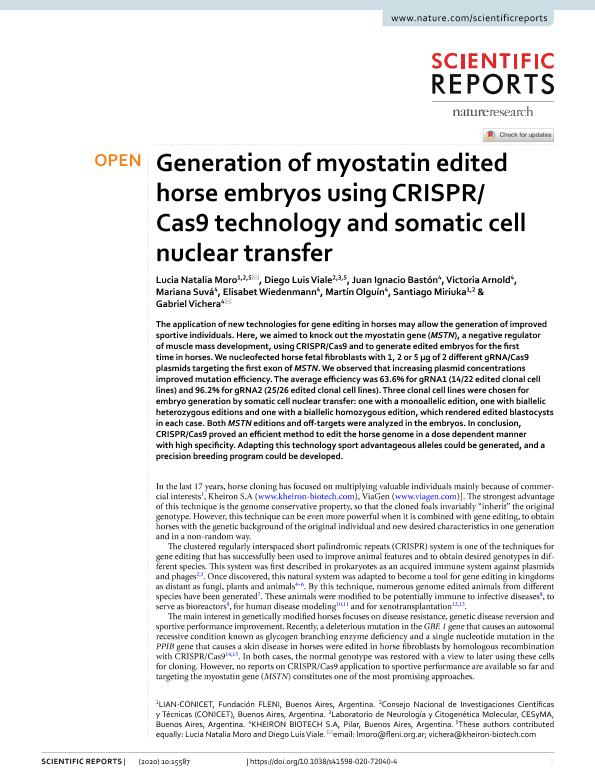Artículo
Generation of myostatin edited horse embryos using CRISPR/Cas9 technology and somatic cell nuclear transfer
Moro, Lucía Natalia ; Viale, Diego Luis
; Viale, Diego Luis ; Bastón, Juan Ignacio; Arnold, Victoria; Suvá, Mariana
; Bastón, Juan Ignacio; Arnold, Victoria; Suvá, Mariana ; Wiedenmann, Elisabet; Olguín, Martín; Miriuka, Santiago Gabriel
; Wiedenmann, Elisabet; Olguín, Martín; Miriuka, Santiago Gabriel ; Vichera, Gabriel Damian
; Vichera, Gabriel Damian
 ; Viale, Diego Luis
; Viale, Diego Luis ; Bastón, Juan Ignacio; Arnold, Victoria; Suvá, Mariana
; Bastón, Juan Ignacio; Arnold, Victoria; Suvá, Mariana ; Wiedenmann, Elisabet; Olguín, Martín; Miriuka, Santiago Gabriel
; Wiedenmann, Elisabet; Olguín, Martín; Miriuka, Santiago Gabriel ; Vichera, Gabriel Damian
; Vichera, Gabriel Damian
Fecha de publicación:
09/2020
Editorial:
Nature
Revista:
Scientific Reports
ISSN:
2045-2322
Idioma:
Inglés
Tipo de recurso:
Artículo publicado
Clasificación temática:
Resumen
The application of new technologies for gene editing in horses may allow the generation of improved sportive individuals.Here, we aimed to knock out the myostatin gene (MSTN), a negative regulator of muscle mass development, using CRISPR/Cas9 and to generate edited embryos for the first time in horses. We nucleofected horse fetal fibroblasts with 1, 2 or 5 µg of 2 different gRNA/Cas9 plasmids targeting the first exon of MSTN. We observed that increasing plasmid concentrations improved mutation efficiency. The average efficiency was 63.6% for gRNA1 (14/22 edited clonal cell lines) and 96.2% for gRNA2 (25/26 edited clonal cell lines). Three clonal cell lines were chosen for embryo generation by somatic cell nuclear transfer: one with a monoallelic edition, one with biallelic heterozygous editions and one with a biallelic homozygous edition, which rendered edited blastocysts in each case. Both MSTN editions and off-targets were analyzed in the embryos. In conclusion, CRISPR/Cas9 proved an efficient method to edit the horse genome in a dose dependent manner with high specificity. Adapting this technology sport advantageous alleles could be generated, and a precision breeding program could be developed.
Palabras clave:
CRISPR-Cas9
,
Gene Edition
,
SCNT
,
Embryos
Archivos asociados
Licencia
Identificadores
Colecciones
Articulos(SEDE CENTRAL)
Articulos de SEDE CENTRAL
Articulos de SEDE CENTRAL
Citación
Moro, Lucía Natalia; Viale, Diego Luis; Bastón, Juan Ignacio; Arnold, Victoria; Suvá, Mariana; et al.; Generation of myostatin edited horse embryos using CRISPR/Cas9 technology and somatic cell nuclear transfer; Nature; Scientific Reports; 10; 1; 9-2020; 1-15
Compartir
Altmétricas



